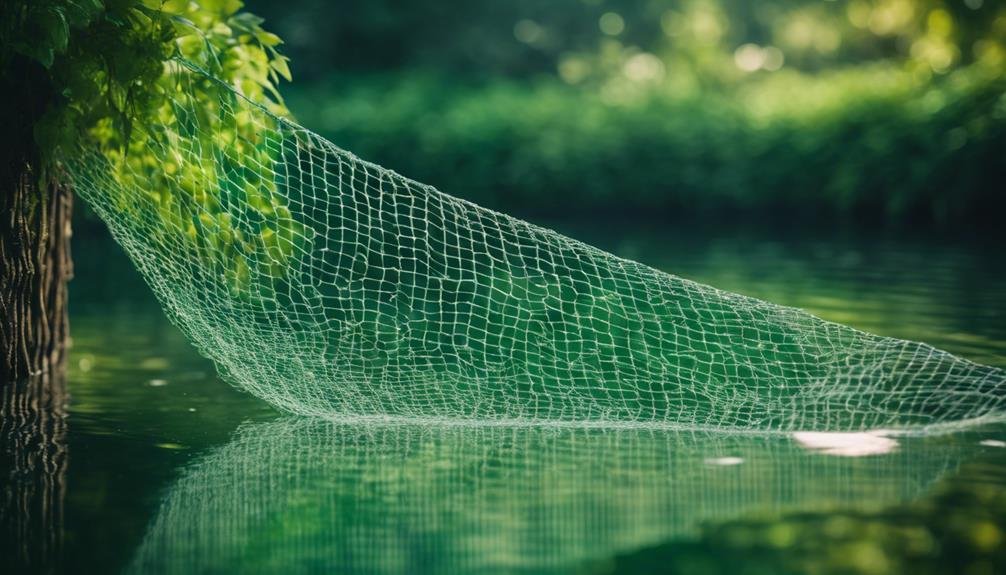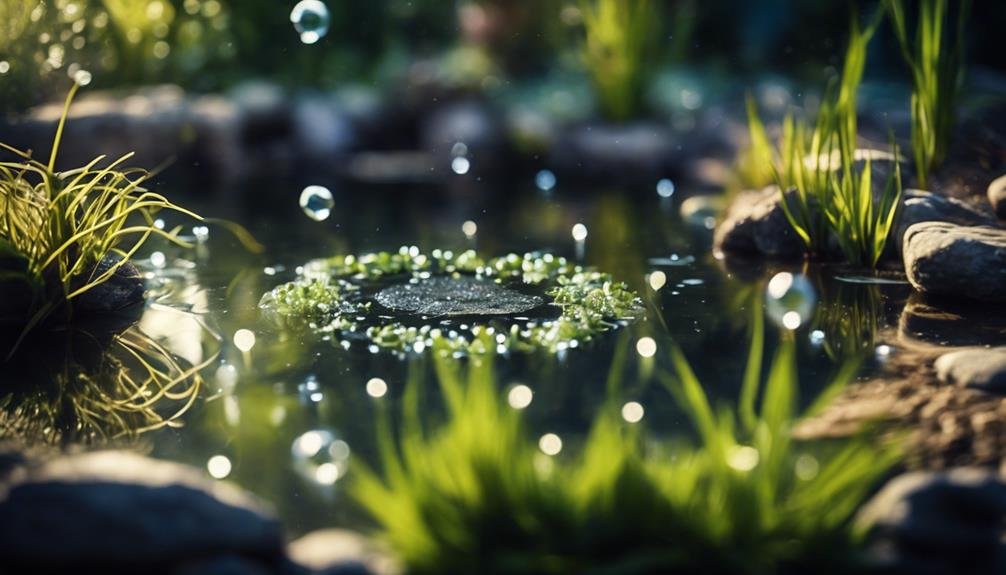To keep your pond clean in an eco-friendly way, opt for natural enzyme cleaners derived from plants and microorganisms. These cleaners effectively break down organic waste without harming the environment.
Biodegradable pond filters are excellent for removing debris and harmful contaminants, ensuring a healthy pond ecosystem. Consider using eco-friendly skimmer nets made from sustainable materials like bamboo and recycled plastics for regular maintenance tasks.
For algae control, try using beneficial bacteria, barley straw, or UV clarifiers as organic alternatives. These methods are safe for aquatic life and help maintain water clarity.
Sustainable aeration systems powered by solar or wind energy are also beneficial for improving water quality and supporting the well-being of pond inhabitants.
To achieve clear water, consider using plant-based clarifying agents such as chitin and guar gum. These products are effective in keeping your pond water clean and free from impurities.
By exploring these eco-friendly options further, you can ensure that your pond remains healthy and sustainable for years to come.
Natural Enzyme Cleaners
Enzymes from nature are a fantastic eco-friendly option for keeping your pond water clean and healthy. These enzymes contain special proteins that break down organic waste such as leaves, algae, and fish waste without the need for harsh chemicals. They're derived from plant and microbial sources, making them safe for the environment and aquatic life. Unlike chemical treatments, natural enzyme cleaners don't disrupt the delicate balance of your pond's ecosystem.
Using natural enzyme cleaners is simple. Just add the recommended amount to your pond water, and let the enzymes work their magic. They accelerate the breakdown of organic matter, reducing sludge buildup and keeping your pond water clear. These cleaners are especially beneficial during times of increased debris, like in the spring and fall.
One of the great things about enzyme cleaners is their long-lasting effects. Unlike traditional chemicals that quickly dissipate, enzymes continue to work until all the organic matter is consumed. This makes them a cost-effective and low-maintenance solution for maintaining a pristine pond environment while being gentle on the surroundings.
Consider incorporating natural enzyme cleaners into your pond maintenance routine for a healthier and more vibrant aquatic habitat.
Biodegradable Pond Filters
Let's delve into biodegradable pond filters, which are made from eco-friendly materials and offer efficient water filtration while being kind to the environment. These filters break down naturally, ensuring minimal ecological impact while effectively purifying water in ponds.
Eco-Friendly Materials
Switching to biodegradable pond filters made from sustainable materials like coconut fibers or recycled plastics is a smart choice for maintaining a healthy pond ecosystem. These filters are gentle on aquatic life and the environment, as they naturally break down without leaving behind harmful waste.
Coconut fiber filters, derived from the sturdy outer husk of coconuts, are a renewable resource that releases beneficial nutrients as they degrade. This helps nourish aquatic plants without posing any threat to fish or other pond inhabitants.
On the other hand, filters made from recycled plastics give a new purpose to materials that would otherwise contribute to landfill or ocean pollution.
By opting for biodegradable filters, we can reduce our environmental footprint while effectively removing debris, excess nutrients, and contaminants from pond water. Their porous structures efficiently capture particles, ensuring clear and pristine conditions.
With regular maintenance and timely replacements, these eco-friendly filters not only keep our ponds clean but also align with our sustainability values.
Filtration Efficiency
Biodegradable pond filters offer eco-friendly benefits while also meeting high standards of filtration efficiency for optimal water quality. Striking a balance between sustainability and performance is crucial, which is why we carefully assess various biodegradable filters to ensure they excel in key areas.
These filters are designed to provide effective mechanical filtration by capturing large debris, leaves, and residue, promoting biological filtration to support beneficial bacterial colonies in breaking down organic matter, and offering chemical filtration to eliminate dissolved pollutants and maintain water chemistry.
Our top-rated biodegradable filters stand out for their innovative designs and use of cutting-edge materials. Crafted from renewable resources such as plant fibers or recycled materials, these eco-conscious solutions not only cleanse your pond but also reduce environmental impact.
With their exceptional filtration efficiency, you can trust that your pond water will stay clear and healthy, creating a thriving environment for aquatic life.
Maintenance Requirements
Maintaining biodegradable pond filters is effortless and offers significant environmental benefits. Unlike traditional filters that add to plastic waste, these eco-friendly options break down naturally, reducing their carbon footprint.
Let's delve into the maintenance requirements for three common biodegradable filter media options.
Firstly, coconut fiber filters only need to be replaced every 6-12 months. They're highly absorbent and cost-effective, making them a popular choice.
Peat moss filters, on the other hand, should be replaced every 3-6 months. They excel at water purification, ensuring a clean pond environment.
Recycled paper filters require more frequent replacement, typically every 2-4 months. They're affordable and sustainable, making them a great eco-friendly option.
While coconut fiber and peat moss filters have longer replacement intervals, recycled paper filters demand more attention. Nonetheless, all three options decompose naturally, eliminating waste concerns.
Regular rinsing and periodic replacement are the primary maintenance tasks. By opting for biodegradable filters, we reduce our environmental impact and enjoy clear pond water. With minimal effort, we can actively contribute to a greener future for our aquatic ecosystems.
Eco-Friendly Skimmer Nets

Using skimmer nets made from eco-friendly materials is a great way to maintain a clean and healthy pond while minimizing our impact on the environment. These nets are designed with sustainability in mind, ensuring they're effective and environmentally friendly.
One popular option is bamboo skimmer nets, which are both durable and renewable. The netting is often made from recycled materials like repurposed fishing nets or plastics, promoting a circular economy.
Additionally, skimmer nets made from natural fibers such as jute, sisal, and hemp are biodegradable and compostable, offering a truly eco-conscious solution.
Manufacturers now offer skimmer nets with handles made from recycled plastics or FSC-certified woods, further reducing their environmental footprint.
Organic Algae Control
To keep your pond healthy and algae-free, it's important to use organic methods. One effective way is by introducing beneficial bacteria, which can help reduce algae growth by consuming excess nutrients that algae thrive on.
Another natural solution is using barley straw, which releases compounds that inhibit algae growth as it breaks down. For more severe algae problems, a UV clarifier can be added to disrupt algae cells and prevent them from reproducing.
It's crucial to follow instructions carefully when using organic algae control products to avoid harming the pond ecosystem. By combining these methods with regular maintenance like skimming and cleaning, you can ensure your pond remains clear and thriving without the need for harsh chemicals.
A little effort in using these eco-friendly techniques can go a long way in maintaining a beautiful and sustainable water feature.
Sustainable Aeration Systems

Let's delve into sustainable aeration systems, which efficiently circulate air to enhance water quality and support aquatic life. These eco-friendly systems incorporate solar panels or windmills to reduce environmental impact and foster a thriving pond ecosystem. By harnessing renewable energy sources, these systems not only benefit the environment but also promote a balanced and healthy aquatic environment.
One example of a sustainable aeration system is the Solar Oxygenator, which operates silently and effectively using solar power. This device oxygenates the water, supporting fish and plant life while maintaining a clean and clear pond.
Another option is the Windmill Aeration System, which harnesses wind energy to aerate the water naturally. These systems aren't only cost-effective but also environmentally friendly, making them ideal choices for pond owners looking to improve water quality in a sustainable way.
Energy Efficient Options
To enhance energy efficiency in pond maintenance, it's essential to consider sustainable aeration systems. These systems play a crucial role in reducing energy consumption while effectively oxygenating and circulating pond water.
Opting for energy-efficient alternatives like solar-powered aeration systems can be highly beneficial. These systems utilize renewable solar energy to power air pumps and circulators, eliminating the need for traditional electricity and offering long-term cost savings and environmental benefits.
Wind-powered aerators are another eco-friendly option that utilizes wind turbines to generate power for water circulation, making them ideal for areas with consistent wind patterns.
Additionally, exploring low-voltage aeration systems, efficient pump designs, and timer-controlled aeration cycles can further optimize energy usage by operating at lower voltages, incorporating efficient pump technologies, and running aeration cycles only when necessary.
Air Circulation Benefits
Incorporating sustainable aeration systems not only boosts energy efficiency but also plays a crucial role in maintaining proper air circulation in pond ecosystems. Ensuring sufficient oxygen levels is vital for supporting a thriving aquatic environment, and these eco-friendly systems offer a dependable and environmentally conscious solution.
By gently moving the water, aeration systems prevent stagnation and facilitate the natural exchange of gases. This process is essential for replenishing oxygen levels, which are necessary for the well-being of fish, plants, and other aquatic life forms. Moreover, effective aeration supports the breakdown of organic matter, helping to reduce the accumulation of harmful substances and uphold a harmonious ecosystem.
Furthermore, these systems contribute to controlling algae growth by promoting water movement, which disrupts the conditions favorable to algae proliferation. Not only do sustainable aeration systems offer functional benefits, but they also enhance the aesthetics of the pond by creating a visually appealing water surface.
Eco-Friendly Materials Used
Innovative manufacturers of sustainable aeration systems prioritize eco-friendly materials to minimize environmental impact and ensure optimal functionality. By incorporating recyclable plastics and metals, we reduce our dependence on non-renewable resources and promote sustainability.
Our dedication to eco-conscious practices extends to our manufacturing processes, where we prioritize energy efficiency and waste reduction.
An essential component of our sustainability efforts involves utilizing renewable energy sources. This includes the integration of solar panels to power our facilities, wind turbines to harness wind power, and hydroelectric generators to convert water flow into electricity.
Plant-Based Clarifying Agents
Plant-based clarifying agents are becoming increasingly popular for maintaining clear pond water. These natural alternatives aren't only eco-friendly but also highly efficient in removing suspended particles and unwanted microorganisms from the water. One well-liked option is chitin, sourced from crustacean exoskeletons. Its unique chemical composition allows it to bind to impurities, making it easier to eliminate them.
Another plant-based clarifier is guar gum, extracted from the guar plant. It acts as a thickening agent, enhancing the performance of mechanical filtration systems.
Saponins, obtained from soap nuts, serve as natural surfactants that disperse oils and greases, preventing the formation of unsightly films on the water's surface.
Conclusion
When it comes to pond cleaning, opting for eco-friendly solutions is crucial to protect aquatic life and the environment. Natural enzyme cleaners, biodegradable filters, skimmer nets, organic algae control products, plant-based clarifiers, and sustainable aeration systems are all excellent alternatives to harmful traditional methods.
By using these environmentally friendly products, we can keep our ponds clean and clear while also reducing our impact on the ecosystem.
For example, natural enzyme cleaners break down organic waste in the pond without harming fish or plants. Biodegradable filters help to remove debris and pollutants without releasing harmful chemicals into the water. Skimmer nets are effective in removing leaves and other debris from the surface of the pond, preventing them from sinking and decomposing.
Organic algae control products utilize natural ingredients to keep algae growth in check without disrupting the balance of the pond. In addition, plant-based clarifiers help to improve water clarity by binding suspended particles together for easier filtration. Sustainable aeration systems provide oxygen to the pond, supporting healthy fish and plant life while preventing stagnation.
By incorporating these eco-friendly products into our pond maintenance routine, we can enjoy a beautiful and thriving aquatic environment without causing harm to nature.

